Europe's online source of news, data & analysis for professionals involved in packaged media and new delivery technologies
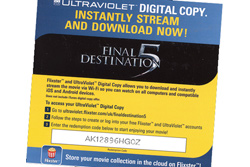
ANALYSIS: Few winners, so far, in 'The Installation Game'
It is not enough to leave cloud-based digital video download in the hands of technologists. Content creators and vendors alike must deliver the promise of home entertainment and keep it simple for all consumers. For the moment, it is not simple, laments BOB AUGER, President of Newmérique. The success of DVD rests on its simplicity. The home entertainment industry should remember the target audience before it asks them to play 'The Installation Game.'
It is safe to assume that readers of this website have an above-average understanding of the technology of DVD, Blu-ray and online digital delivery. DVD-Intelligence attracts more than its fair share of experts in the field, who are more technologically savvy than the average consumer.
So, in what follows, try to shed prior assumptions and imagine that you are simply a consumer of packaged home entertainment. Someone with an open mind about technology, but who just wants to escape from the pressures of daily life and settle down on the sofa to watch a really good movie.
Recent innovations in home entertainment appear to ignore the simple KISS equation (keep it simple, stupid!). Boffins and their bosses trade the simple and the easy options for complexity that drives consumers into the arms of the pirates, particularly when it comes to audio and video entertainment. Where once there were push-buttons for 'play', 'rewind' and 'on/off', today's devices feature complex menus, warnings, copyright notices and error messages.
What is the average user to make of this typical message: You do not have the rights to play this file. Go to the content provider's Web site to find out how to obtain the necessary play rights. The desire for content protection is understandable, but is it appropriate to be so abrupt, when all the viewer wants to do is watch the film that they have just purchased online?
Content owners and distributors need to control the entire pipeline, from data warehouse to consumer and back again. This includes the interception of 'error messages' and their replacement by more user-friendly dialogue. Something along the lines of Make yourself comfortable, your entertainment is about to start
Steve Jobs understood the rules and iTunes, iPhone and iPad are a testament to his foresight. Yet at times Apple has sacrificed simplicity for a closed system, one that excludes some video formats and digital downloads, even when legally acquired.
The simple task of inserting tape or disc into a slot has turned into a confusion of different digital systems that compete to make things more difficult for the consumer. Did the industry learn nothing from the 'format wars'? A common Uni-Digital Video format, with a projected lifespan of 15 years or more, would benefit content creators and consumers alike.
When it comes to delivering the escapism and excitement of cinema and video entertainment to the big screen at home, not even Apple has found a solution as simple and foolproof as the DVD and Blu-ray disc. If what you want is low-resolution on your mobile devices and you have a 4G connection or lots of local storage, the cloud has incompatible solutions galore. However, on the primary screen in your household, digital disc still holds sway.
Give or take a few flashing green zeros, technology has transported viewers from the real world for more than three decades. The big bright TV in the corner of the room is simple to use, needs no upgrades and has an average life span of between 8 and 10 years. VHS (and Betamax) had a good 20 years and most tapes still play on today's TVs, if you can find a machine. CD, DVD and Blu-ray discs play as well on modern devices as they did when released. These are genuinely future-proof formats.
No silver lining in the Cloud
Yet Ultraviolet digital copies downloaded as recently as January 2012 will no longer play, having been superseded by a new file format that requires previous downloads to be replaced. It's the wrong message to send to consumers who 'Download to own.' In search of playability, rather than features, it is no surprise that they turn to dodgy DVDs or to 'content sharing' links. In so doing, they open up their system to malware and their broadband account to suspension.
The ability to create data on the products of one brand and read it on those of another is fundamental to many of the digital devices that all of us rely on.
Imagine a situation in which an iPhone owner could not call a Blackberry user, because each mobile phone maker uses a different data format. Or ten different brands of DVD, each unplayable on equipment made by other manufacturers. Consumers would rise up against such madness and, after a brief 'format war,' would demand compatibility.
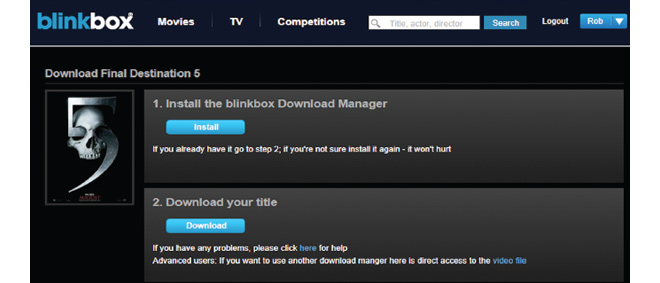
Online delivery is bedevilled by proprietary video 'standards' and incompatible systems of digital rights management. Instead of maximising revenues from creative content, which allows profits to be reinvested in new production, the industry has allowed the digital supply chain to syphon off more than its fair share of the 'consumer dollar.'
The cost of replicating and distributing a DVD or Blu-ray disc is a one-time overhead of a few pennies, with almost no continuing support costs to worry about. Content delivery from the cloud requires substantial and on-going investment. The need to support multiple formats incurs high start-up costs for content encoding and the same high overhead applies to all titles, from the blockbuster feature to the straight-to-video animation.
Packaged media has taken consumers on a journey of ever-better, more reliable content delivery, from the early beginnings on cassette in the 1980s to today's Blu-ray disc on a 55-inch flat panel. The studios realised quickly that disc media is a major source of income and the consumer electronics companies fought format wars to ensure their format had a place in the home. A DVD player from the last century can still play disc and look good today, 15 years after it was replicated.
Over the years since the introduction of the CD, the disc has found favour in homes across the planet. The beauty of the disc is its simplicity: all that the user needs is the ability to insert the media into a slot and press play. Although there is at least one verified tale of physical media placed in the wrong slot: Two DVDs in the electric toaster, in fact, and the culprit sat on the naughty step for a good while after that.
The enjoyment of home entertainment should require no technical knowledge or special skills. Yet with digital delivery, what was once as easy as posting a letter can become as complex as programming the clock on a VHS machine. Apart from the fact that there is nothing to watch if digital goes wrong, in which case there may still be a line of flashing zeros on the screen.
The problem is usability and not technology. The sales pitch that promises so much falls down at the interface between the customer and device and the result is frustration and rejection. Features that seemed a good idea at first prove too complex and remain unused. The complexity of multiple operating systems, the variety of video formats and the hurdles of DRM are difficult enough for experts to understand.
Unlike disc, the parameters of digital delivery are not set in polycarbonate. There is a constant desire to tinker with formats and portals, so that what you think you own one week has become unplayable the next. You think this judgement too harsh?
It's time to play the 'Installation Game'
Imagine that you have bought a Blu-ray disc in your nearest superstore. On the face of the box, which is labelled 'Triple Play,' there is a sticker promising Blu-ray, DVD and UltraViolet Digital Copy. Turn it over and you'll see that UltraViolet digital copy allows you to stream via Wi-Fi and download to your computer and compatible Android, iPhone, iPod and iPad devices. (Remember that weasel word: compatible.)
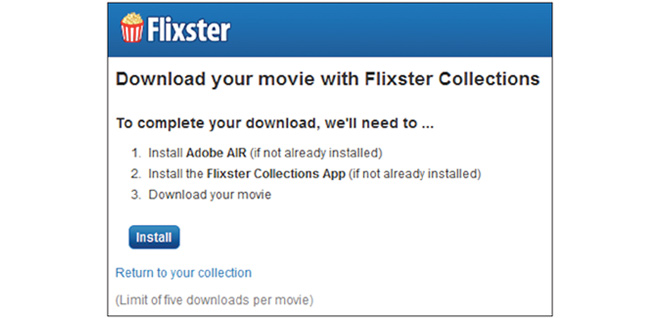
There's also a warning that it doesn't include an iTunes file and a note about the 'redemption deadline.' There's a sticker on the sleeve as well, inviting you to access an 'Online Movie' when you use your loyalty card at the checkout. On your till receipt is a message that your digital file now is associated with your store card account and is waiting for you to stream or download at any time.
Question 1: Can you make a list of what you have just purchased?
You certainly have a Blu-ray disc - that's what you went in for - but what else is there?
For the answer, tear open your shrink-wrapped pack NOW! In the case are two discs, a Blu-ray and a DVD, with only the smallest of logos to differentiate them. If all you want is instant home entertainment, you put the BD in the player and relax. But maybe you plan to use the digital copy? It is advertised as a 'triple play' title, so you were maybe expecting three discs? Wrong answer!
Score one point if you answer 'Two discs' but lose it again if you say the price you paid includes a digital download. In fact, it includes two: in different formats, at different bitrates and different aspect ratios. One of them will play on multiple devices, the other will not, so how do you know which is which?
Before you choose, you remember that the pack said something in bold red letters about an UltraViolet redemption deadline, so you had better sort that out before it expires.
Question 2: How long have you got before you redeem your digital copy?
The easy answer to that question is that you used your store card to make the purchase, so that one digital copy is already registered and waiting for you in the cloud. Score one point if you knew that and a further two if you have heard of UltraViolet. Your smartphone bleeps - you have a new message!
As you have recently bought a selected DVD or Blu-ray from your local superstore, we think it's only right to give you a little bonus. So, you can now watch your movie online, anytime. (You can watch forever - no time limits). Click *here* at any time to view your purchase. If you have any questions, visit our *Help Centre*. Thanks and enjoy the movie!
Question 3: Are you impressed by the prompt reaction of UltraViolet to your new acquisition?
If your answer is yes, lose three points. The Tesco/Blinkbox tie-up responded first, within 15 minutes of leaving the store. UltraViolet doesn't know yet that you exist. The friendly message from Tesco is an example of how things should be done: others should learn from their approach.
Over to your family computer, where you open the email and click on the link. It is at this point that you leave the warm and friendly environment. It starts well enough, with a link to the 'download manager' and a second link to 'download your title.' Depending on your internet connection speed, this process can be completed in an hour or two but your task isn't over yet.
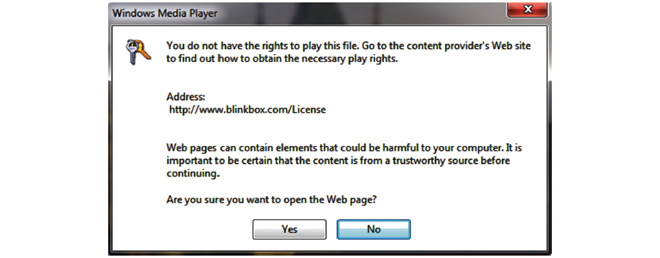
Click on play and you may get several messages. It starts with the one about not having the rights to play the file, which is at the top of this story, then there's A component of Windows Media Player needs to be upgraded, followed by the warning, Web pages can contain elements that could be harmful to your computer. Are you sure you want to open the Web page?. Next is This website wants to install a Media Rights Acquisition plug-in. If you trust the website, click here. Then there's Do you want to install this software? This file can potentially harm your computer, after which comes We have detected that you require an update to your Microsoft DRM, which takes you to a Microsoft 'Security component upgrade', a download and a restart.
Now you are ready to repeat the whole process with UltraViolet and Flixster. Simply create an UltraViolet account, activate it Within three days, connect to Flixster and create another account, enter the redemption code that you found in the box, and then?
Download the UltraViolet version of the file, which will take another hour or two to arrive and may involve yet more updates and upgrades.
Final question: Do you still want to watch a movie? Or would you rather call in at your local bar, have a drink to steady your nerves and pick up a dodgy download on DVD while you are there?
How did you do? Regardless of how many points you accrued, all of us are the losers in this morass of media rights messages, update requests and incompatibility warnings.
In tests for this article, Blinkbox consistently provided the best picture quality and could be streamed and played on the widest range of devices. In particular, the content was easily available to stream on a Samsung Smart TV and played, with very minor buffering, on a 1.3 Mbps connection.
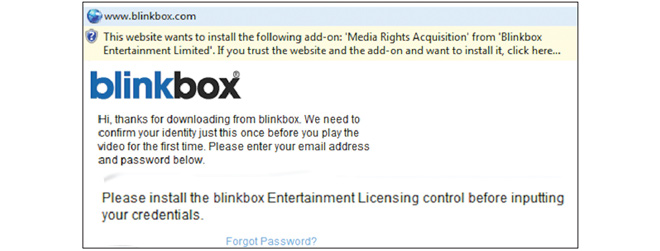
In contrast, the UV/Flixster experience was disheartening, with lower resolution video and overly complex sign-up procedures. It was made worse by the fact that files dating from early 2012 would no longer play by August, as the result of a change to the file format. 'Download to own' should never mean 'Download to own' each time you want to watch the film.
The UV files will not play on all smart TVs and you may see the message, Cannot play media because you do not have the correct version.
If viewers are lucky, they will follow a trail of technical messages, arrive at the right site and be smart enough to know which button to click for their operating system. At, which point, they may receive the message, Your device does not support downloads of this type or else the player is not available for your device's operating system.
If the Walkman had displayed error messages such as these, Sony Corporation would never be the success in home entertainment that it is today. More than 200 million users figured out how to enjoy audio cassettes on the move, without the need for a 20-page manual and a helpline.
DVD rapidly replaced VHS, once consumers understood the simplicity of the system. More importantly, the wide range of content available on disc means that throughout the supply chain -from creator to consumer - everybody can benefit.
Online video delivery will eventually become ubiquitous but only when the many obstacles are removed, starting with the elimination of multiple proprietary standards, leaving just Uni-Digital Video to stand alongside Blu-ray and DVD. Come on, content creators and CE manufacturers - you know it makes sense!

The simplicity of using a loyalty card (or smartphone) at point of purchase must replace the complexity of the current registration process - Blinkbox and Tesco have already showed the way. Let every CE device connect to the card or phone to authorise playback, wherever and whenever members of the user-group wish.
It is not enough to leave the future of online video in the hands of technologists. Content creators and vendors alike must deliver the promise of home entertainment and keep it simple for all consumers. For the moment, it is not simple. We should vow to do better as we return to our day job as members of the DVD-Intelligence community.

BOB AUGER, founder of consultancy Newmérique, has worked in most sectors of sound and video production. After the BBC and Granada, he joined Manchester film company Greendow in late 1970s, where he worked on early experiments with stereoscopic 16 mm film production. He later joined the board of Molinare, the leading London post house, before co-founding Electric Switch in 1993, creating Videodisc, CD-i and VideoCD titles. In 1997, the company became the first independent DVD authoring house in the UK and delivered the first-ever DVD with anaglyph 3D content. Following a year in Hawaii producing 400 educational DVDs for North America and China, Bob returned to the UK in 2002. Since then he specialises in tracking and analysing the full range of video delivery technologies. Contact: bob@newmerique.com
This is one of many editorial features included in the annual DVD and Beyond 2012 magazine. Ask for your free copy.
Story filed 13.10.12




















